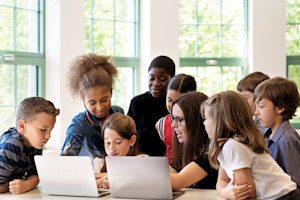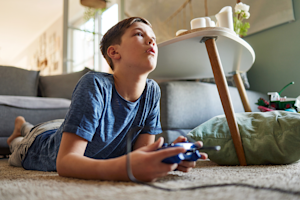
Digital wellness
Celebrating Media Literacy Week: Media Stamped wins international recognition
Award-winning digital literacy resources now available to Canadian educators.
Read article
Matthew Johnson
Director of Education, MediaSmarts

Online pornography combines two of parents’ least-favourite things to discuss with our kids: sex and the internet. It’s important, though, to make sure that kids aren’t getting their sex education – or their ideas about healthy relationships and consent – from porn.
Fewer kids seek out porn than you may think: MediaSmarts’ Young Canadians in a Wireless World research found twenty percent of kids in grades 7-11 look for pornography online. A third of kids, though, see it without looking for it — and almost half of youth take steps to keep from seeing it.
Given the likelihood that youth are going to see pornography, not to mention the many messages they get about sex through other media, it’s important to start talking to them about healthy relationships and sexuality at an early age. While less than half of kids say that a trusted adult has talked to them about porn, three-quarters of those who have talked to an adult say the conversation helped them.
If you learn that your child has seen porn, don’t make assumptions about how it happened: they might have looked for it, but they may also have found it while looking for information on sexuality, they may have seen it accidentally, or someone may have sent it to them. Ask them how it happened before planning your next step:
Remember though, you don’t have to wait until kids have seen porn to talk about it! In fact it is recommended to proactively discuss it - in age appropriate ways - so they can take steps to avoid it, and/or are prepared for if and when they do see pornography.
Here’s are some tips on talking to kids about pornography and sexualized media at different ages:
Young children
You don’t have to talk about pornography to prepare young kids to deal with it. Instead, you can talk about things like consent, gender stereotypes, managing online content and healthy sexuality and relationships.
Tweens and teens
Research suggests that the tween and early teen years are the best time to start talking specifically about pornography. The best approach at this age is an ongoing dialogue that acknowledges their interest in relationships and sex as normal and helps them develop the critical thinking skills to make good online decisions.
Another important message is that nobody should ever make them watch porn without their consent. Whether it’s somebody sending them a nude picture, a friend sending a link to a pornographic video, or somebody showing something on their phone, tell kids they always have a right to say ‘no’ if they don’t want to see it. If someone doesn’t take ‘no’ for an answer, kids should block them and tell you what happened right away.
To build on this discussion, discourage the common “culture of sharing” among youth where intimate images are forwarded on to other people without their consent. To learn more visit telus.com/HowWouldUFeel. The #howwouldUfeel videos and resources are based on key findings from the MediaSmarts research, Non-Consensual Sharing of Sexts: Behaviours and Attitudes of Canadian Youth.

Award-winning digital literacy resources now available to Canadian educators.
Read article
Learn how gaming and gambling features blur for kids.
Read articleLearn how screen time triggers dopamine responses. Students explore digital media's biological impact and develop healthier digital habits.
Watch video